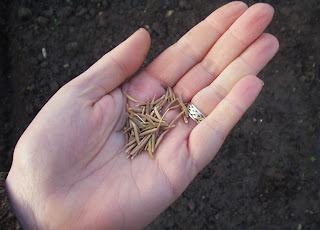Ooft, that was a bad one, even for me.
Yes, it's another slow-growing, space-occupying weird vegetable. Sorry those of you with small gardens!
Scorzenera (Scorzonera hispanica) is also known as Spanish Salsify or False Salsify (and occasionally appears on Masterchef as just 'Salsify', making me wobbly with suppressed fury at inaccurately named veg, and in danger of spilling my second-cheapest-in-the-supermarket rioja*), and is another member of the ever-reliable Asteraceae family. It's mostly grow for its cylindrical root (that can grow up to 1 meter long, though never more than 2cm in diameter. Good luck pulling that out in one piece), though like Salsify the spring shoots & flowerbuds are also edible. The name comes from the Italian
scorza - bark &
negra - root, referring to the black skinned roots.
It's not a common sight in vegetable gardens, which is a shame. It's a low maintenance crop, with no pest or disease problems. It also repels carrot root fly, and thus is Awesome.
Like Parsnip & Salsify, it's prone to forking on recently manured soil. Or stony soil. Or clay soil. Or when Mars is in retrograde. Digging helps. When I had heavy clay soil I found digging a narrow trench a spade deep & filling it with compost produced good results (but better results came from not bothering with digging a trench & planting Jerusalem Artichokes instead).
Sow the seeds in drills 1cm or so deep in rows 15cm apart, thinning out the seedlings to 15cm apart (or sowing the seeds 15cm apart if, like me, you find pulling up seedlings a little bit heartbreaking).
After that, they can pretty much be left to their own devices, but for the occasional weeding (by hand - they are delicate), and a splash of water in dry spells. They can be harvested in the autumn, or left in the ground to produce 'chards' in the spring. Treat them the same way as Salsify really.

The black skin is not exactly inedible (Mikeyfox eats it, but then he also eats mushy pea sandwiches), but is corky & a bitter. You can peel the roots before cooking (they'll need immersing in water with a splash of lemon juice to stop them discolouring), but they slip off easily after they've been boiled or roasted. The roots can be baked, boiled, fried, sauteed, battered & deep fried, made into fritters, croquettes or gratins. Here's a simple one to get you started.
Scorzonera & Mushrooms300g Scorzonera
150g chestnut mushrooms, sliced
20g butter
1 tbs olive oil
1 lemon
2 cloves garlic, chopped.
salt & pepper
1 tbs fresh parsley, chopped
Peel & chop the scorzonera, and place in a bowl of water with a squeeze of lemon juice. Put the butter & oil in a pan over a medium heat & add the scorzenera. Cook for 4 or 5 minutes, until golden. Add the mushrooms & garlic, and cook another minute or so. Reduce the heat & add the juice of the lemon. Cover & leave to simmer for 10 minutes. Season & add parsley.
Serve with crusty bread & a salad.

The same recipe works with all the ingredients thrown into a dish & baked in the oven for 30 minutes (including the lemon rind) & finished with parsley.
Next time, vegetables - in cake!
*I know how to party.










